Among the personalities that made Columbia such an interesting place in the twentieth century, perhaps none were more colorful than Captain Frank Foster (F. F.) Frakes. Better known as “Bowser,” Captain Frakes made his living by living on the edge as a barnstormer and stuntman.

1938 Camel cigarette ad highlighting Bowser Frakes.
In 1913, Bowser saw his uncle fly an old Curtiss-Wright pusher. It was love at first sight. With his uncle, Bowser learned everything he could about flying the flimsy planes from the infancy of aviation. Bowser thought he had learned enough to help the Allies with the Great War (WWI), but Uncle Sam did not see it that way—Bowser lacked the two years of college required to be a pilot in the early air force.
During a 1955 interview, Bowser said of his time in WWI, “The closest I came to flying was when a Maury County mule kicked me about 30 feet through the air.” Grounded by the army, Bowser’s main objective was to transport mules to Europe to aid with the war effort.
When the war was over, though, Bowser found himself in luck. The army had hundreds of surplus planes they were all-too-happy to sell to would-be pilots like Frakes. Bowser took what he learned from his uncle and hit the road as a barnstormer, becoming one of the best. Soon after, Bowser landed a job with Curtiss-Wright as a test pilot. But, the Great Depression came along and, in its wake, Bowser’s job was lost, forcing him back to barnstorming.
Bowser and his comrades in the “air circus” quickly learned that things were tough all over; people were no longer paying to watch the old air acts with simulated dogfights and acrobatics that once brought in thousands of spectators. Bowser knew he had to come up with a new act.
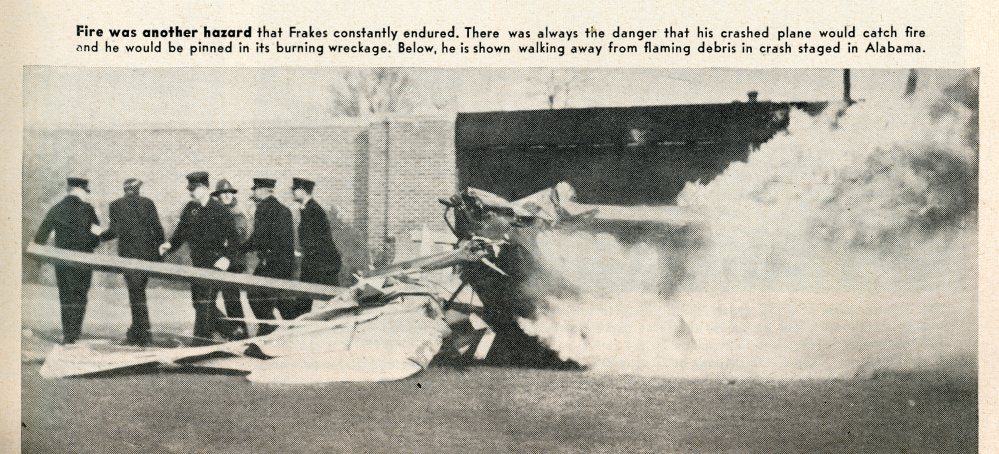
From Flying, July 1951
Bowser said, “I got the idea of cracking up planes before a crowd which would pay admission to see me risk my fool neck.” In 1929, before a crowd of 30,000 spectators, he performed his first “crack up.”
Jack Dealy, in a feature for Flying magazine, wrote, “The crowd roared approval—and Frakes was on his way to a world’s record for walking away from crackups.” The title of the feature in Flying should give you an idea of how many times he cracked up. It was titled, “He Walked Away from 99 Crashes.” (Bowser crashed into homes, barns, cars, and, once, a body of water during his career spanning ninety-nine crashes.)
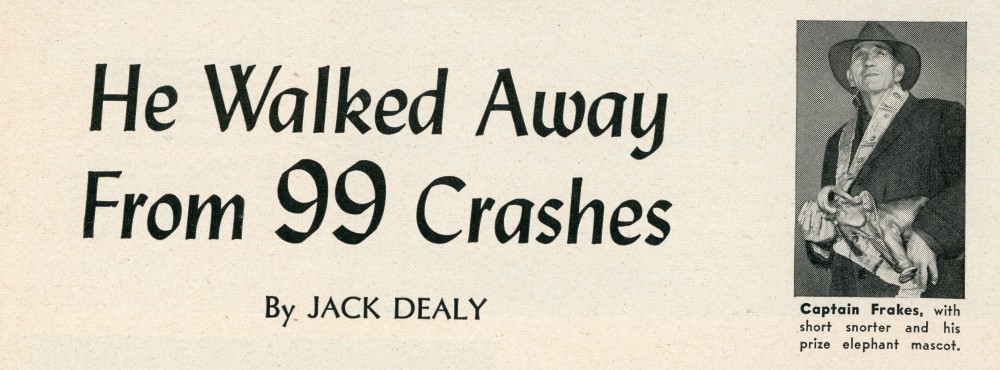
From Flying, July 1951
All along this journey of cracking up planes, Bowser had to stay one step ahead of the law. The Civil Aeronautics Authority (CAA) did not much care for Bowser’s occupation. As soon as it was announced Capt. F. F. Frakes was going to perform a crackup in a town, CAA agents would alert authorities with orders to nab Bowser. Toward the end of his career as a crackup pilot, Bowser was known to feign injuries and go straight from the crash to the ambulance. Once away from the prying eyes of the spectators (and the police), he would have the medics drive the ambulance to either his hotel or the local train station.
In September 1938, Bowser knew the law was close, so he again played hurt. The medics threw Frakes in the back of the ambulance and, before the car took off, two men climbed into the back with the “patient.” Bowser looked at the men, but assumed they were doctors when one of them said they were going to the hospital.
According to The Lincoln Star, “No!” replied the flier, “I’m all right, hurry up and get me to my hotel so I can get out of town.”
“Well,” retorted one of the men, “If you’re all right then we’re going to the jail, not the hotel.”
That’s when Bowser realized the two men were the town sheriff and one of his deputies.
The Wild West-era of air shows was coming to a close, but a new world war loomed on the horizon. Bowser decided to offer his services to the British by writing a letter to their embassy in Washington, DC. According to Bowser, “I told them if British intelligence would map out Adolf Hitler’s residence for me I’d be glad to rid the world of his presence. I said I thought could fly a plane carrying high explosives right down his chimney.”
The Brits thanked him for the offer, but declined. That did not stop Bowser from enlisting in the Royal Air Force where he served honorably from 1941 until 1942 as a flight instructor. In ’42, he transferred to the United States Air Force where he finished the war.
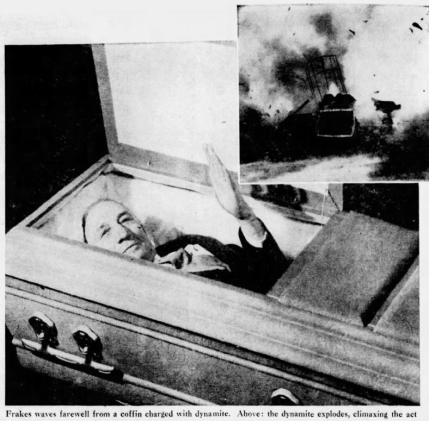
“Casket of Death,” June 5, 1955, The Tennessean.
Having served through another world war, Bowser, now in his fifties, had to find a new show. Cracking up planes was out—he needed something a little easier to do in his golden years. So, Bowser developed the “Casket of Death” routine, where he lined a coffin with dynamite, sealed himself inside, and had someone light the fuse. Then, BOOM!
Later, at close to sixty years of age, he started performing a rocket routine. Bowser would saddle onto a rocket and have it launched only to explode in midair.
Bowser is still considered an aviation legend. His story has been told in countless newspaper articles and magazines, including Flying and, most recently, Air & Space by the Smithsonian. He flew as a stuntman in thirty-four movies, including Hell’s Angels and Devil Dogs, and was also featured in numerous newsreels during the 1930s. In 1938, at what was probably the height of his career as a “crackup pilot,” Bowser was sponsored by Camel cigarettes and he was featured in several of their print ads.
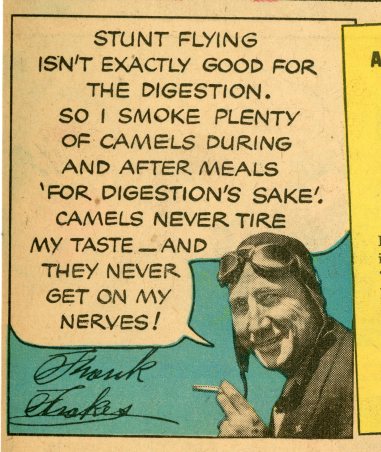
From Camel cigarette ad, 1938
In Columbia, Tennessee, many look back fondly on their experiences with Bowser Frakes. Those of us too young to have known him, only wish we could have met the legend. Today, after a daring life of stunts and near-misses, Frank Foster Frakes is resting peacefully in Rose Hill Cemetery, a far cry from the airfields he knew so long ago.
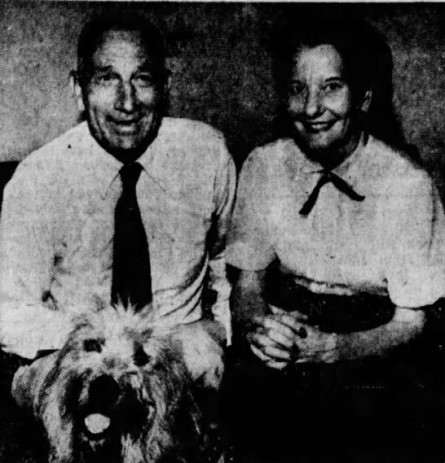
Bowser, his wife Carol, and his dog, Ike. Bowser Frakes was a favorite among the children of Columbia, as was his dog, Ike. The kids of Columbia would feed Ike chocolate bars as treats. As far as anyone knows, the chocolate never made Ike sick. August 23, 1954, St. Louis Post-Dispatch.
Cited:
Dealy, Jack. “He Walked Away From 99 Crashes.” Flying, July 1951, p. 26.
Rayburn, Taylor. “Death Diver!” The Tennessean (Nashville, TN), 05 Jun. 1955, p. 110.
Staff. “Pictures of Captain Frakes Crashing Plan Thru House.” The Lincoln Star, 11 Sept. 1938, p. 3.
Start, Clarissa. “An All-Around Daredevil.” St. Louis Post-Dispatch, 23 Aug. 1954, p. 27.

My parent dental lab was in the same building as his shop. I got to see him and Ike everyday. Love him, his wife Carol and of course Ike. I was still in elementary school.
LikeLiked by 1 person
Bowser is my Grandfather and was a one of a kind man. His daughter Jo Anne was my Mother. Loved his stories and would spend as much time as I could with him. Ike his dog and JoAnne his black bear would always be on the back of his car when he would visit us in Birmingham.
LikeLiked by 1 person
Thanks for the comment, Perry. I enjoyed meeting you at the library in Columbia several months ago. Your grandfather is a true Maury County legend!
LikeLiked by 1 person